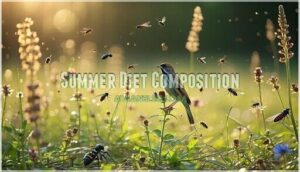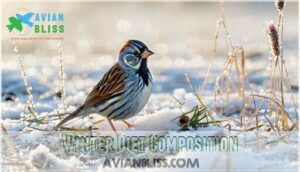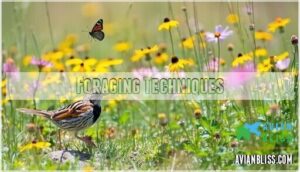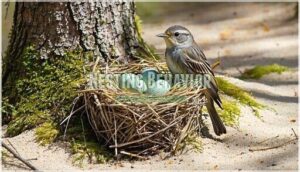This site is supported by our readers. We may earn a commission, at no cost to you, if you purchase through links.
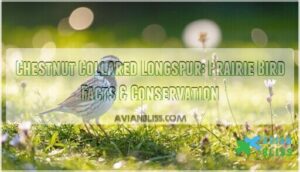
This bird thrives on freedom, calling grasslands home and favoring wide-open spaces where it finds seeds and insects for fuel.
Nesting close to the ground, it welcomes spring with bubbly songs that seem to tumble through the wind.
The chestnut-collared longspur is a true ground artist, always on the move, always adapting.
Yet, changes in prairie habitats have made life tough for these wanderers.
Stick around—there’s more to uncover about their world and what’s being done to help.
Table Of Contents
- Key Takeaways
- Chestnut Collared Longspur
- Diet and Foraging
- Nesting Behavior
- Conservation Status
- Ground Adaptations
- Frequently Asked Questions (FAQs)
- Is the chestnut-collared longspur endangered?
- What is the difference between a chestnut-collared Longspur and a Lapland Longspur?
- Is a longspur a sparrow?
- What does the Chestnut-collared Longspur eat?
- What is the difference between a Smith’s longspur and a Lapland Longspur?
- How does the birds diet change with the seasons?
- Where does the bird migrate to and from?
- What are the Chestnut-collared Longspurs key physical characteristics?
- How does the birds habitat change throughout the year?
- What are the main threats to the birds conservation?
- Conclusion
Key Takeaways
- You’ll spot chestnut-collared longspurs in open prairies, showing off bold chestnut collars and adapting to life on the ground.
- You’ll see their diet shift from insects in summer to grass seeds in winter, highlighting their flexibility and survival skills.
- You’re reminded that habitat loss, invasive species, and pesticides threaten these birds, making conservation efforts crucial.
- You can help protect them by supporting habitat restoration and learning more about grassland bird conservation.
Chestnut Collared Longspur
You’ll recognize the Chestnut Collared Longspur as North America’s smallest longspur species, measuring just 6 inches long with striking seasonal plumage changes.
This prairie specialist thrives in short-grass and mixed-grass habitats where grazing or fire maintains the sparse vegetation it needs to survive.
Physical Characteristics
You’ll immediately recognize this small prairie bird by its distinctive size—just 6 inches long with a 10.5-inch wingspan.
The chestnut collared longspur (Calcarius ornatus) showcases dramatic plumage types between seasons.
Males develop striking breeding plumage featuring bold facial patterns of black and white, complemented by rich chestnut nape patches.
Their stout gray beak shapes help crack seeds efficiently, while dark pink leg colors provide sturdy support.
Females maintain subtle camouflage coloring year-round with buff and gray streaking.
Identification Features
You’ll spot breeding males by their striking facial pattern of black and white markings framed by a chestnut collar. This chestnut collared longspur (Calcarius ornatus) displays yellow throat patches and jet-black belly during breeding season.
Females show muted brown and gray streaking for camouflage. Look for their stout gray beak shape, dark pink leg color, and distinctive white tail feathers with black triangular markings.
These plumage colors make bird identification straightforward. Understanding key bird size comparisons is essential for accurate species identification in the field, using complete concepts and basic bird identification techniques to ensure accuracy.
Habitat Preferences
You’ll find these grassland birds thriving in short-grass and mixed-grass prairie habitats where native vegetation creates the perfect home.
They prefer areas with sparse, low vegetation maintained through natural grazing or controlled burns.
Key Habitat Preferences:
- Prairie Habitat with vegetation under 30 cm tall
- Native Grasslands dominated by indigenous plant species
- Moderate disturbance from grazing, mowing, or fire
- Open areas with bare ground patches and clubmoss cover
Diet and Foraging
If you’re curious about what fuels these small prairie birds, you’ll discover their diet changes dramatically with the seasons.
The Chestnut Collared Longspur switches from a protein-rich insect menu during breeding season to an all-seed diet when winter arrives, which is a significant change in their dietary habits, highlighting the importance of seasonal adaptations.
Summer Diet Composition
You’ll discover these prairie specialists shift their summer foraging strategies dramatically.
Grasshoppers and crickets dominate their insect consumption, comprising over 50% of biomass intake. Their food variety expands to include ants, beetles, caterpillars, and leafhoppers.
Summer foraging peaks during warm daylight hours when prey abundance soars.
Seed intake continues alongside protein-rich choices, with nutrient uptake supporting breeding demands through this diverse bird diet approach.
The birds also rely on supplemental bird seed products to sustain themselves during periods of scarcity.
Winter Diet Composition
When winter arrives, you’ll witness a dramatic dietary shift in these prairie birds.
Seed Consumption becomes their lifeline as Insect Decline forces complete dependence on plant matter.
Winter Foraging focuses entirely on Grassland Seeds from native and cultivated grasses.
This transformation from insectivorous birds to granivorous birds showcases remarkable adaptation.
Their bird feeding strategies shift to pure grain-based nutrition, demonstrating flexible bird foraging behavior that guarantees survival through harsh prairie winters.
The birds’ ability to adapt to a healthy winter diet is vital for their survival during this period, highlighting the importance of a healthy winter diet and pure grain-based nutrition for their well-being.
Foraging Techniques
You’ll watch these insectivorous birds master their Ground Foraging techniques with remarkable precision.
Their bird foraging behavior shifts seasonally, adapting Forage Adaptation strategies perfectly. Granivorous birds like these excel at Seed Gathering while maintaining Insect Catching skills.
Bird foraging and feeding habits include:
- Running and walking while scanning soil surfaces
- Picking items directly from ground vegetation
- Flushing insects with short chase flights
- Gleaning food from low prairie plants
- Switching between bird diet and foraging modes seasonally
No Food Storage occurs—they eat what they find immediately.
Nesting Behavior
You’ll notice the chestnut-collared longspur hides its nest in the grass, shaping a small depression close to protective cover.
Watch as females line these nests with soft materials, creating a safe spot for 3 to 5 eggs each season.
Nest Placement
Hidden beneath grass clumps or near protective objects like dried cow manure, the nest location offers both security and camouflage.
Here, the female handles all nest construction, carefully choosing shallow depressions for her ground nests.
This ground nesting lets her use natural cover for concealment, making predator detection difficult.
Good nest site choices and clever use of nest materials play a huge role in the longspur’s nesting behavior. The use of artificial bird nesting boxes can also support conservation efforts by providing alternative nesting sites.
Nest Description
Settling low in the grass, the Chestnut Collared Longspur crafts a simple ground nest.
The female leads construction, scraping a shallow depression and lining it with grass, rootlets, and soft feathers.
These nest materials offer comfort and insulation, and clever nest camouflage blends the structure with its surroundings, safeguarding egg laying.
Ground nests hug the earth, and nest site choices support both ground nesting and the longspur’s unique approach to bird nesting habits.
Nesting Facts
Mother Nature’s blueprint shows you just how resourceful the Chestnut Collared Longspur can be.
In these birds, nest construction always starts with a simple ground scrape.
You’ll see a clutch of 4-5 eggs, with one sole parent handling the entire incubation period. Their nesting habits mean you might spot several broods per season, often re-nesting on the same open nesting grounds when previous attempts fail.
Conservation Status
You’ll find that the Chestnut-collared Longspur faces serious decline, mainly because of habitat loss and changing land use.
Understanding its conservation status helps you see why protecting these prairies is so important.
Threats to Population
Across open prairies, chestnut-collared longspurs face real threats driving grassland bird population decline.
Picture these main culprits:
- Habitat loss and urban expansion shrink your prairie home.
- Pesticide use slashes insect prey, hurting chick survival.
- Invasive species crowd out native grasses, disturbing nesting spaces.
- Climate change brings harsher weather, shifting breeding windows.
These combine, making conservation status for this endangered species increasingly urgent.
Understanding the bird conservation status is essential for developing effective protection strategies.
Conservation Efforts
After learning about the challenges facing Chestnut Collared Longspurs, let’s spotlight their conservation efforts. Groups focus on Habitat Restoration and Wildlife Preservation, using Conservation Funding and smart Environmental Policy shifts.
Partnerships support grassland conservation, research, and on-the-ground work. Protecting these birds isn’t a solo act—it’s teamwork. Your choices, big or small, can help write the story of species protection and change the game for their conservation status.
Conservation efforts rely on understanding grassland birds to make informed decisions.
| Conservation Strategy | Goal |
|---|---|
| Habitat Restoration | Restore native grasslands |
| Species Protection | Prevent further decline |
| Conservation Funding | Support projects |
| Wildlife Preservation | Safeguard ecosystems |
| Environmental Policy | Align laws with needs |
Protected Areas
If you’re searching for the Chestnut-collared Longspur, you’ll have the best luck in National Parks, Wildlife Refuges, and Conservation Zones that maintain vast, open grasslands.
These protected areas—like Ecological Reserves and designated Protected Landscapes—are lifelines for grassland birds.
Such places aren’t just scenic stops; they anchor bird conservation and keep avian ecology in balance.
So, every patch counts for species like the Longspur.
Ground Adaptations
You’ll find the Chestnut-collared Longspur is specially built for life on the prairie, with features that help it forage, hide, and nest right on the ground.
These birds’ legs, feet, and plumage make it easy for them to thrive among grasses and bare soil.
Great Ground Adaptations
After looking at challenges to its survival, let’s see how the Chestnut-collared Longspur stands strong on open prairie.
You’ll spot distinct ground adaptations, making this grassland bird a true specialist:
- Ground Claws help with Terrain Navigation and Foraging Strategies.
- Compact body suits mixedgrass prairie life.
- Effective Nesting Habits for open ground shelter.
- Burrowing Behavior isn’t just instinct—it’s survival, blending perfectly into bird habitat.
The Chestnut-collared Longspur’s ability to thrive in its habitat is due to its strong ground bird adaptations, which enable it to thrive in its habitat with its specialist features.
Ground Gleaners
When you watch a Chestnut-collared Longspur at work, you’ll see a master of Ground Foraging.
This grassland bird species walks or runs over open terrain, picking seeds and insects straight off the earth.
As a grounddwelling bird species, it’s tuned to Insect Catching and Seed Consumption, adjusting its strategy for Forage Quality.
Its keen Terrain Navigation supports efficient Ground Gleaning, especially during active breeding habits.
Migration Patterns
Once you’ve glimpsed these ground gleaners in action, you’ll spot their knack for epic journeys. Every spring and fall, Chestnut-collared Longspurs cross massive grasslands using specific Flyway Routes.
Migration Timing is precise—most leave in October and return by April. Picture them relying on:
- Vast open Stopover Sites
- Seasonal Movements shaped by climate
- Wintering Grounds in the Southwest.
Bird migration patterns like these guarantee their story continues. The conservation efforts involve using Grassland Bird Tracking systems to monitor their movements and understand the importance of ground gleaners.
Frequently Asked Questions (FAQs)
Is the chestnut-collared longspur endangered?
You won’t find the chestnut-collared longspur on the endangered list, but it’s considered vulnerable.
This grassland bird’s numbers have dropped sharply, mostly due to lost habitat and changing prairies.
Conservation efforts are underway to address the issue of lost habitat.
What is the difference between a chestnut-collared Longspur and a Lapland Longspur?
One fun fact: Lapland Longspurs breed farther north than most songbirds.
You’ll notice chestnut-collared Longspurs flash a chestnut collar and black belly, while Laplands show rufous nape with more streaked, buffy coloring and a longer tail.
Is a longspur a sparrow?
You might think a longspur is a sparrow, but it isn’t.
Longspurs belong to their own group, named for their long hind claws.
They share grassland habitats with sparrows but have different looks and family trees.
What does the Chestnut-collared Longspur eat?
Like a true survivor on the prairie, you’d snack mostly on insects—grasshoppers, beetles, crickets—when it’s warm.
Come winter, you’d shift gears and focus on seeds from grasses and weeds, keeping meals grounded, literally.
What is the difference between a Smith’s longspur and a Lapland Longspur?
You’ll spot Smith’s longspur by its buff belly and distinct wing stripes.
While Lapland Longspur shows a black face in males and a chestnut nape.
Both prefer open fields, but their plumage and songs set them apart.
How does the birds diet change with the seasons?
Winter’s chill won’t let you feast on plump grasshoppers—you’ll switch gears and hunt seeds instead.
When summer heats up, you’ll crave protein, loading up on insects and spiders to fuel nesting and growing chicks.
Where does the bird migrate to and from?
Every fall, you’ll see these birds heading south from the Great Plains to spend winter in the dry grasslands of Arizona, Texas, New Mexico, and north-central Mexico.
Come spring, they’re back on open prairie to breed.
What are the Chestnut-collared Longspurs key physical characteristics?
Who knew camouflage could be this sharp?
You’ll see a stocky grassland bird with a chestnut collar, black belly, and yellow cheek.
Females blend in with streaked brown, while males flash bold black, white, and chestnut.
How does the birds habitat change throughout the year?
You’ll notice the habitat shifts from open, grazed prairies in spring and summer to dry grasslands or deserts in fall and winter.
The birds avoid crowded vegetation, preferring shorter grasses, open spaces, and minimal trees year-round, which helps them thrive in their preferred habitat.
What are the main threats to the birds conservation?
If you thought suburban sprawl was just humans stretching out, think again—habitat loss from farming, urban growth, and invasive weeds squeeze wild spaces.
Pesticides, cowbird parasitism, and shrinking prairie patches put these birds at real risk.
Conclusion
Picture the wind bending tall grasses as a chestnut collared longspur darts through open spaces, weaving its life into the prairie’s fabric.
You’ve seen how this bird thrives on the ground, adapts to changing seasons, and faces direct threats from habitat loss.
Every small action you take—supporting habitat restoration or learning more—helps the chestnut collared longspur.
Your awareness matters, keeping this unique ground artist moving freely across its prairie home for generations to come.
- https://www.fws.gov/project/habitat-monitoring-wintering-longspur
- https://wgfd.wyo.gov/media/1352/download?inline
- https://naturecounts.ca/nc/socb-epoc/species.jsp?sp=chclon
- https://gazette.gc.ca/rp-pr/p2/2024/2024-06-19/html/sor-dors123-eng.html
- https://gf.nd.gov/wildlife/id/grassland-birds/chestnut-collared-longspur

